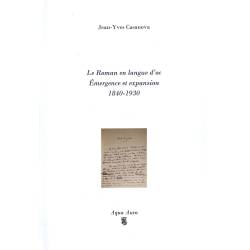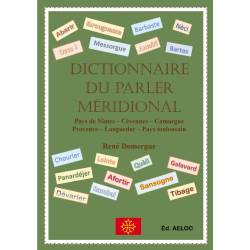Recently added item(s)
No products
Product successfully added to your shopping cart
There are 0 items in your cart. There is 1 item in your cart.
Histoire - Etudes
- New Selection
- Books
- Music
- Videos - DVD
- Miscellaneous
- Revues, Journaux
Links
Le Roman en langue d’oc - Émergence et expansion 1840-1930 - Jean-Yves Casanova
L-9782957062928
New
This product is no longer in stock
40,00 €
Le Roman en langue d’oc - Émergence et expansion 1840-1930 - Jean-Yves Casanova. This study puts various novels in langue d'oc into perspective, from La Roubinsouno prouvençalo to Joseph d'Arbaud's La Bèstio dóu Vacarés, an exemplary attempt to create a remarkable novelistic language. A corpus of some fifty novels: well-known, little-studied or unknown. Aqua Aura.
Data sheet
| Type | Paperback |
| Year | 2024 |
| Language | French + Occitan |
| Pages | 1100 |
| Format | 16 x 21 cm |
| Distributor | Aqua Aura |
| ISBN | 978-2-957062-92-8 |
More info
Le Roman en langue d’oc - Émergence et expansion 1840-1930 - Jean-Yves Casanova
Despite earlier and more recent attempts, notably by Marcel Carrières, Charles Camproux, Philippe Gardy and Emmanuel Desiles, the history of the first novels written in langue d'oc, at least in prose, has not really been analyzed in its entirety, geographical scope and chronology.
This volume attempts to remedy this shortcoming by putting into perspective the various novels in langue d'oc published between 1840 and 1930. The first date corresponds to the appearance of the genre in the 19th century, with texts printed in volumes, in various deliveries, in the form of serial novels, or even in manuscript form; this opening date refers to Garcin's La Roubinsouno prouvençalo, the first opus of the genre. The cut-off date is the years following the publication of Joseph d'Arbaud's La Bèstio dóu Vacarés, an exemplary attempt to create a remarkable novelistic language. The present study includes a corpus of over fifty novels, some well-known, some little-studied, others still unknown, remaining in manuscript or published in periodicals that are not easily accessible, such as Estève de Valèri Bernard or the Toulouse novels published in Lé Gril.
This work therefore focuses on this chronological perspective, while providing a broad analytical and sociological overview of these novels so that they can be placed in a broader movement. Finally, this work poses a series of questions about the definition of the genre, its socialization, its permanence or absence in the history of Ocre literature, the readership associated with it, and then attempts a comparison with similar situations, those of the emergence of Catalan, Corsican and Breton novels.
Cover illustration: Vivent Astruc, manuscript by Joseph Bourrilly (photograph and personal collection of P. Fabre).
Editions Aqua Aura.
The author:
Jean-Yves Casanova, writer and honorary university professor, has published works on Oc and French literature. His research focuses on the 19th and 20th centuries, in particular the work of Frédéric Mistral, to which he has devoted two volumes and numerous articles. He is also the author of studies on Apollinaire, Stendhal, Proust and Céline.
Content:
Avant-Propos
Introduction
Le roman : un genre dans tous ses états
Roman et temps
Socialisation du genre
I : Espace et temps du roman
1 : Naissance du roman
Définition d’un corpus
Sociolittérature occitane
Le miroir catalan
Typologie émergente : Corse et Bretagne
2 : Lueurs dans l’absence
Vers, proses médiévales et romans
Décadence, trait d’union ?
Un « météore » inespéré : Jean l’an prés de l’abbé Fabre
3 : Un miroir piqueté
L’autre langue
Quel choix pour quelle langue ?
Romanciers d’oc en français
Images du Méridional et roman
Trois destinées exceptionnelles : Le Roy, Cladel et Lombard
II : L’Émergence provençale et bordelaise
1 : L’Exception Garcin
Une Ambiguité fondamentale
L’Ailleurs des robinsonnades
Réécriture et fantasme provençal
2 : Nouvé Granè, par qui tout arrive
Gelu et Marseille
Genèse d’un roman
Misère du progrès et progrès de la misère
3 : Le foisonnement urbain : Aix, Marseille et Bordeaux
Guitton-Talamel, du Reinard à Pèire de Prouvènço
Bouillon-Landais et les trois mascos
Pierre Mazière et le destin contrarié de Fino
Louei Barri ou les déboires du Fada
Alexis Pigalio : entre memori et roman
Jules Gelin et Lou Maset de la pignudo
Théodore Blanc : un romancier dans la tourmente
4 : Valèri Bernard : Homo homini lupus
Une vie entre la plume et le pinceau
Estève : les tourments de la création artistique
Angèlo Dàvi et l’expression du désir
Bagatóuni: Niflo et l’anarchisme du don de soi
Lei Bóumian : poursuite d’un rêve insensé ?
Qui aime bien, châtie bien : Jouglar felibre
5 : Louis Funel
Un écrivain « intransijant »
Une Idéalisation rurale : Li Masajan
Bàgnus: science, ésotérisme et histoire
Haro sur le Félibrige : Jan Cougourdan
Naïs, roman inachevé ?
Mei XXVIII jour : un réserviste sur les crêtes
Minervo, un roman niçois
6 : Le « retard » rhodanien :
– Villeneuve-Esclapon : un Roumiéu inachevé
– Jean Monné : un félibre exemplaire
– Maurìci Raimbault : Agueto dans la modernité
– Charles Boy : un félibre dans « un païs de nèblo e de tubèio »
– Henri Giraud : images d’un amour contrarié
– Félix Gras et l’épopée des Rouge
– Pierre Devoluy : Lis Ausard, un roman « au Désert »
– Noël Blache : une bataille parodique
– Pierre Pansier et la réécriture de Tartarin
– Marius Jouveau : Arles sous la Révolution
III : L’Expansion occitane
1 : Le Languedoc, ailleurs impossible ?
Achille Mir : Messo ou Lutrin, roman et représentation de la langue
Arthur Caussou : une restitution de l’Histoire occitane
Charles Pélissier : à la recherche des temps passés
Jan Castagno : le roman des Cévennes
2 : Toulouse et Lé Gril :
La Poulido del poun de Pièrril de la Kakè: une prédiction tragique
Guilhaoumet : des Abanturos toulousaines et gasconnes
Pamèlo : des Désaïcis toulousains
3 : L’Avancée « béarnaise et gasconne » :
-V. Lalanne : une vengeance singulière
Henri Pellisson et la défense de la tasque
Yan de Hustach : de l’idylle béarnaise aux tranchées de Verdun
Yulien de Caseboune et l’exaltation des vertus du terroir
Édouard Moulia et les horreurs de la guerre
Honoré Dambielle : un attachement pathologique au terroir
Célestin Laffargue : les déboires de Poulét
4 : Ailleurs du temps et de l’espace :
Benezet Vidal : un romancier sous-estimé
Enric Mouly : un cant éminemment rouergat
Paul Eyssavel : un roman du désir impérieux
IV : Deux artistes de la langue
: Joseph Bourrilly
Entre Provence et Maroc
La Rèino Sabo: « i’a mai eici que lou rouman »…
Vivènt Astru
Une écriture artiste ?
: Joseph d’Arbaud
Vers La Bèstio…
Genèse d’une écriture
Publication, réception et structure du roman
À l’errour
Un Autre-Soi dans lou Grand Abime
Transcendance de la langue
Conclusion
Bibliographie
Index
Reviews
No customer comments for the moment.
 English
English Français
Français Occitan
Occitan











